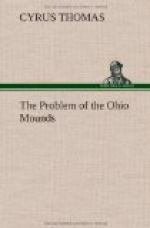Having thus united their forces the Lenape and Mengwe declared war against the Alligewi, and great battles were fought in which many warriors fell on both sides. The enemy fortified their large towns and erected fortifications, especially on large rivers and near lakes, where they were successfully attacked and sometimes stormed by the allies. An engagement took place in which hundreds fell, who were afterwards buried in holes or laid together in heaps and covered over with earth. No quarter was given, so that the Alligewi at last, finding that their destruction was inevitable if they persisted in their obstinacy, abandoned the country to the conquerors and fled down the Mississippi River, from whence they never returned.
The war which was carried on with this nation lasted many years, during which the Lenape lost a great number of their warriors, while the Mengwe would always hang back in the rear leaving them to face the enemy. In the end the conquerors divided the country between themselves. The Mengwe made choice of the lands in the vicinity of the great lakes and on their tributary streams, and the Lenape took possession of the country to the south. For a long period of time, some say many hundred years, the two nations resided peacefully in this country and increased very fast. Some of their most enterprising huntsmen and warriors crossed the great swamps, and falling on streams running to the eastward followed them down to the great bay river (meaning the Susquehanna, which they call the great bay river from where the west branch falls into the main stream), thence into the bay itself, which we call Chesapeake. As they pursued their travels, partly by land and partly by water, sometimes near and at other times on the great salt-water lake, as they call the sea, they discovered the great river which we call the Delaware.
This quotation, although not the entire tradition as given by Heckewelder, will suffice for the present purpose.
The traces of the name of these mound-builders, which are still preserved in the name “Allegheny,” applied to a river and the mountains of Pennsylvania, and the fact that the Delawares down to the time Heckewelder composed his work called the Allegheny River “Allegewi Sipu,” or river of the Allegewi, furnish evidence that there is at least a vein of truth in this tradition. If it has any foundation in fact there must have been a people to whom the name “Tallegwi” [Footnote: There appears to be no real foundation for the name Allegewi, this form being a mere supposition of Colonel Gibson, suggested by the name the Lenape applied to the Allegheny River and Mountains.] was applied, for on this the whole tradition hangs. Who were they? In what tribe and by what name shall we identify them? That they were mound-builders is positively asserted, and the writer explains what he means by referring to certain mounds and inclosures, which are well known at the present day, which he says the Indians informed him were built by this people.




